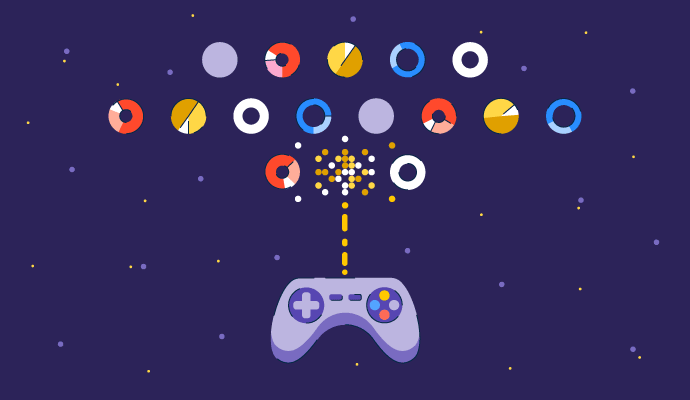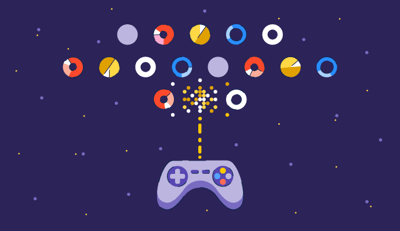
Dynamic moves, crystal clear animation, and quirky audio resounding as characters move on the screen—my childhood was a coffee table book of games.
As I enjoyed the "thrill" of setting new high scores and winning virtual tournaments, I developed a penchant for exploring game engines and their role in automating game operations in detail.
While part of the developer crew, I took my time and interacted with game developers and engineers to go into the backend of gaming animation and prototyping. That's when I realized that games are a patchwork of multiple departments, like graphic design, UI development, and quality assurance. I was also informed of multiple worries game developers deal with, like hardware inconsistencies, low-level API compatibility, and overloading of memory storage.
I evaluated 40+ game engines on my own, out of which I shortlisted the 7 best games and engines that offered an integrated development environment for stimulating high-quality games.
These game engine software are top-rated in their category, according to G2 Grid Reports. I’ve also added their monthly pricing to make comparisons easier for you.
Did you know, according to a GMI report, the global game engine market was valued at $2.42 billion in 2023 and is expected to grow at a CAGR of over 12.3% through 2032, driven by the increasing adoption of virtual reality (VR) and augmented reality (AR) in game development.
Game engines are software development kits (SDKs) that game developers use to design, animate, and program the front end and the back end of high-quality games. During my analysis, I explored various gaming studios and could jazz up games with just a few clicks.
But that's not all. As a game developer, I had to examine the nuances of virtual characters, scene transitions, responsive physical movements, and overall simulations to optimize the game production lifecycle.
A game code editor is pre-equipped with multiple production libraries and software packages, which reduces the frequent function declaration and package calls. Thus, I could design web interfaces, customize code, and integrate graphical features all in one place.
While game engines offered centralized development control, they also integrated with visual studios and 3D modeling engines to further automate the game design and prototyping. Some game engines also offered AR/VR visualization, geometric modeling, parametric modeling, and lightning-fast production rendering to help non-developers build new games.
I spent weeks trying and testing multiple game engine software and evaluating their features, pros and cons, real-time reviews, and customer service offerings to narrow down this list of the 7 best game engine software in 2025. During analysis, I also referred to artificial intelligence to shortlist key parameters, benefits, and hardware and software specifications of each tool and analyze key patterns from real-time and authentic reviews on G2 to highlight customer satisfaction and market relevance of each product.
These products have been tested and analyzed in a way that summarizes the entire buyer evaluation and shortlisting criteria for you and your teams to make an informed decision. In cases where I couldn’t personally test a tool due to limited access, I consulted a professional with hands-on experience and validated their insights using verified G2 reviews. The screenshots featured in this article may be a mix of those captured during testing and ones obtained from the vendor’s G2 page.
Developing a game involves multiple coding trials and errors. I got the hang of it when I sat down to visualize a gaming concept, sketch it out, and figure out various UI and UX components and integrations essential to supporting my gaming project.
While game engines supported me with multiple elements like design templates, conversation starters, or source code editors, I still felt that coders might require more resources. I took my time to analyze these game engines from a business point of view and enlisted the top features that can optimize the production pipelines for game developers.
Out of the 40+ game engines I considered for making games, I narrowed down the top 7 that offer a culmination of all the features listed above and the required tools and resources to create, ideate, and design better games, even if you have zero to less coding knowledge.
This list below contains genuine reviews from the game engine category page. To be included in this category, a software must:
*This data was pulled from G2 in 2025. Some reviews may have been edited for clarity.
Like Call of Duty or Player of Unknown Battleground, Unreal Engine gave me all the resources and options to build warzone or shooter games. Ranked as a Leader on the G2 Game Engine Grid, Unreal Engine continues to be a top choice for cinematic rendering quality, real-time cutscenes, and AAA-level game production.
The animation and transition features of the Unreal engine left me in awe. I could build jaw-dropping visuals that looked straight out of a high-budget Hollywood production.
From providing low-level graphics programming to multiplayer support to a huge repository of content assets, developing a new game with the Unreal engine felt like a breeze.
Whether you are building a 2D game, integrating VR simulation, or initializing dynamic characters in a new scene, Unreal Engine provides an integrated data studio and even optimizes graphics rendering times. I recently upgraded to Unreal Engine 5, and it felt like a huge leap from earlier versions in terms of fast real-time rendering and animation quality.
Then there is Blueprint, their visual scripting system. It is one of those features which has made game development and monitoring way simpler, as it provides low-code scripting support. It lets you drag and drop logic blocks which fastens the process of game prototype development.
Another highlight is the community and learning resources, which made me reach out directly to my peers for doubts. Even when I was just starting, I found countless tutorials, courses, and forums filled with people eager to help.

What really stood out to me about Unreal Engine is how comprehensive the ecosystem is. It offers everything from high-end rendering to full production pipelines, which makes it a strong pick for immersive game development. That said, there were moments when navigating the vast array of technical features became a bit overwhelming, especially for smaller or less memory-intensive projects. It’s worth noting that several G2 reviewers have also mentioned the steeper learning curve, particularly for developers not focused on AAA-quality shooters.
Performance-wise, I did face some hiccups when launching projects on older hardware. The engine seems to be optimized for more current systems, and that’s consistent with verified reviews on G2, where some users highlighted occasional lag or app crashes on legacy devices.
Still, Unreal’s ability to deliver rich visual storytelling and streamlined game production workflows—without requiring a lot of external tools—is hard to beat once you get the hang of it.
"What I like best about the Unreal Engine is its Blueprint system. Being able to code is still basically needed for game development, but the blueprint system handles almost all of it. How it seamlessly works with Microsoft Visual C++ or whatever your choice coding program is quite remarkable."
- Unreal Engine Review, Paul F.
"Upgrading projects to newer versions of Unreal Engine may occasionally introduce compatibility issues with existing assets or plugins, necessitating additional work for migration"
- Unreal Engine Review, Arjun P.
Dive into the new world of VR immersion with VR gaming and learn how to develop 3D and virtual ecosystems to welcome the next era of gaming.
Unity provided game development services for various industries, such as automotive, real estate, graphic design, interior decoration, and architecture, to design and prototype 2D or 3D models with dynamic illustrations.
If you are a beginner in game development or graphic design, Unity is the ideal choice. I have used it myself for some projects (and spent countless hours building forms and interfaces) and can confidently say it is one of the most versatile game engines out there.
Whether I was a complete beginner or felt like a seasoned developer, the interface felt quite intuitive and user-friendly. I found myself putting together visual prototypes in just a few hours without worrying too much about low-level coding or technical issues.
It also offers visual geometry and sketching options to design new prototypes. If you want to build a 2D zeroes and crosses game or a 3D cooking game, Unity can do it. My projects also ran without interference across multiplayer devices (like PC, mobile, or gaming consoles.)
I also want to highlight the Unity Asset Store. It was a treasure trove of pre-built assets, tools, and templates. I experimented with many environments like forest environments, Times Square backgrounds, or white-sand beaches, and all were available and ready to download.
Finally, I could find the answers to every problems on the community hubs. The forums, Reddit threads, and even YouTube tutorials helped set up the platform. Any support you need is available at your fingertips.

The platform's ability to combine visual geometry, SDK integration, and low-level graphics modeling makes it a compelling choice for developers aiming to build sophisticated pipelines across devices.
That said, I did notice that the pricing structure can feel a bit steep, especially if you're just dabbling or working on a side project. While there's a free version available, many of the more dynamic features are locked behind higher-tier plans—a sentiment echoed by insights from G2 reviewers who found the cost a bit high for hobby-level projects. I also noticed some slowdowns in performance during larger builds, and Unity's stability occasionally dipped when handling bulkier assets or complex files. According to G2 reviews, this isn’t uncommon, especially when working with large-scale projects or switching between versions.
Version updates were another area that gave me pause. At times, upgrading to the latest version caused unexpected hiccups in ongoing projects, requiring time to troubleshoot and realign. And while Unity offers a great range of features, I occasionally wish certain workflows, like lighting bakes or compiling, were quicker.
Still, Unity continues to be a go-to engine for many developers because of how much it packs into one platform. When it’s running smoothly, it opens up a world of creative opportunities for both indie creators and professional teams.
"After using Unity for two years, I can say that it is among the easiest game engines. Since it does not demand any prior programming experience or expertise, it's great for people just starting out in game production. Documentations and lessons on YouTube provide abundant additional support needed to use it.
- Unity Review, Atharva V.
"Unity's huge physics library and scripting functions require very steep learning. Fortunately, it has a huge developer base, hence lots of tutorials. It is too much performance hungry, means computer drains huge resources to just unity causing to crash on bigger projects containing multiple scenes and assets."
- Unity Review, Manav S.
Follow a step-by-step handbook for game development by getting an overview of the 7 stages of game development and aligning your developer requirements accordingly.
Cry Engine was an end-to-end game development framework that offered age creation, developer affinity, and performance boost to kickstart your game creation. Recognized as a Best Contender on the G2 Game Engine Grid, CryEngine stands out for its high-fidelity graphics and immersive UI capabilities, especially for visually rich game experiences.
I could glide through all stages of game development as it offered full source code, a game-integrated development environment, and third-party integrations and plug-ins to simply ideate and design applications.
First, Cry Engine's visual simulator was nothing like I had seen before. The quality of graphics and animations was out of this world. They've got this awesome royalty model where you make 5% royalties if your project is sold for up to $5000 annually.
I could also contact a super-friendly and knowledgeable developer community that is reactive and responsive to your queries and genuinely wants to see you succeed.
I was also impressed with the quick and timely software upgrades of Cry Engine, which ensures that all the recent improvements are reflected in the platform's mainframe environment.

However, working with the backend was more involved than I expected. The codebase relies on C++, which made things feel more complex coming from tools like Unity that use C#. Based on feedback from G2 customer reviews, this shift in language has been a common learning curve for those without an extensive programming background. I also found that while there is a knowledge base available, parts of the documentation feel dated or incomplete, which sometimes led me to look for third-party solutions or spend more time experimenting, a view that’s echoed in several G2 users.
Additionally, the content asset store felt a bit underwhelming. Unlike Unity or Unreal, CryEngine’s marketplace seems more limited in terms of templates and ready-made assets. This made it harder to jumpstart unique projects or prototype ideas quickly—something that verified G2 reviewers have also noted when comparing asset availability across engines.
That said, CryEngine still holds its ground as a visually powerful option for developers who want granular control and stunning output. With some added polish in usability and support materials, it could go from strong to exceptional.
"The developers behind this engine are solid and want their platform accessible. This business model, coupled with a great engine, makes me a happy user of Cry Engine. It is a beautiful physics, graphics, and development platform for all your game dev needs.
- CryEngine Review, Grant B.
"As a level designer, there are not so many tools available for creating the white-boxing stage. However, it's easy to create open levels. But it feels the lack of a tool such as the one from Unity called ProBuilder."
- Cry Engine Review, Daniel G.
Build clear and glitch-free audio experiences within video games and provide an immersive gaming experience with the best audio engine software to take your games to the next level!
What sold me on Godot was its ability to design and develop 2D or 3D multiplayer games compatible with various hardware devices and operating systems.
Also, Godot is free and available to everyone as it is an open-source platform. There are no hidden fees or subscriptions. Because it is open-source, you can access the source code and customize it. Named a niche solution on the G2 Game Engine Grid, Godot is gaining momentum among indie developers for its open-source flexibility and strong 2D rendering backed by a highly engaged community.
Another thing that I benefitted from is the game studio's user-friendliness and intuitiveness. I found the "node-based architecture" relatively easy and perfect for beginner game developers. It breaks your game into manageable pieces and provides visual templates, animations, or 3D modeling services to build appealing user interfaces.
I was also able to easily upload and download files without interruption. The system is lightweight and does not consume a lot of processing power or memory, so your files can run and execute smoothly after you take them to production.
It also worked on pretty much any platform or device, such as Android, iOS, macOS, Linux, and Windows OS. And exporting games? It was straightforward. I was able to get my projects running on PC, mobile, or any new game console.

From open forums to shared plug-ins and collaborative discussions, there's a strong sense of collective knowledge that makes developing with Godot feel less isolating. It’s a great match for creators who thrive in community-driven environments and want to build complete games with a collaborative spirit.
That said, Godot's 3D toolset still feels like it’s catching up to more mature engines. While the 2D experience is widely praised, including by G2 users, 3D development, especially for VR and advanced physics simulations was a bit more limited in my experience. The physics engine occasionally felt under-optimized for high-fidelity environments, and if you're aiming for ultra-realistic visuals, you might find yourself running into some constraints. According to Godot G2 review data, developers with more graphics-intensive needs have echoed similar thoughts, particularly around the engine’s current 3D rendering capabilities.
Still, the momentum behind Godot is exciting. It's lightweight, open-source, and growing fast. And with such an active user base behind it, there’s strong potential for its 3D support to become more competitive in future releases.
"Godot is a user-friendly game engine that is suitable for beginners. Game development is made simpler and quicker by its node-based architecture and support for sprite sheets. It is lightweight; it may function well on PCs with lower specifications."
- Godot Review, Pat E.
"The available tutorials are outdated and can be confusing to follow when using the latest version of the program. There are many changes, and it requires checking the version of a tutorial.
- Godot Review, Roger Alexander E.
GameMaker offers holistic game development coverage and compatibility with multiple content formats and computing devices, which makes it easy to launch and publish new projects.
I was able to brainstorm and construct a user interface with an intuitive and latest drag-and-drop builder. If you are new to coding, like me, you don't have to worry about learning complex programming languages right away. I could build simple 2D and 3D layouts without writing a single line of code, which gave me a huge confidence boost.
But as I got more comfortable, I started exploring the built-in scripting language, GameMaker (GML), which helped me customize my game and add more features.
To add, the user interface was responsive, clean, and crisp. I never got too overwhelmed by the million options or cluttered menus on the main interface.
Apart from the scripting and graphic options, it also provides a large-scale visual library and cutting-edge physics services to control the dynamic movements of avatars on screen. And let's not forget the multiplayer support - such a cool feature if you want to collaborate with your friends and play games together.

The drag-and-drop functionality combined with scripting flexibility really supported a smooth creative flow.
That said, the engine does come with its limitations. For starters, 3D development isn’t part of its core offering. If you're aiming to build expansive 3D environments, GameMaker likely won't meet those expectations. A limitation also noted by G2 user feedback, found it best suited for 2D-only projects. Exporting to multiple platforms also involved a fair bit of setup and manual tweaking.
In my case, managing production pipelines required additional effort, and the ability to export isn’t included by default. It comes with a subscription fee, which some G2 users have called out as a barrier for smaller developers.
The tutorial library is fairly comprehensive, but as someone looking for deeper, more advanced solutions, I occasionally had to step outside the built-in documentation to find the answers I needed. Based on feedback shared across G2 user reviews, this seems to be a shared experience among more experienced developers seeking nuanced technical support.
That said, for those focused on professional-grade 2D design and fluid animations, GameMaker still remains a smart, streamlined option—especially if you’re focused on quality presentation within a well-defined game style.
"Gamemaker is an excellent piece of software that not only helps in making development easy but also quick. It has a lot of tools and technology and overall, the simple coding method it provides also makes it very easy to use. Creating 2d games using GameMaker is a piece of cake."
- GameMaker Review, Subrata S.
"I think it is perfect for platform games, but if you want something more advanced, a more professional level, there are other software options that might serve you better."
- GameMaker Review, Diorling M.
In my opinion, Haxeflixel is a lifesaver. I can design, customize, and manage several game projects from one single codebase.
Be it a platform 2D game or designing additional characters in an existing game, Haxeflixel provides code customization options and full access to a source editor to tweak and pivot the game projects as you need.
The tools feel like magic for game devs - creating graphics, new design levels, and a singular codebase that reduces the scope of any confusion or irritation. Its game engine was incredibly efficient and helped me maintain my focus on game development rather than getting lost in a sea of features.
Another feature that deserves a mention is the cross-platform support. With Haxeflixel, I can write and publish game code and launch it on multiple platforms. I have launched games on various operating systems like Windows OS, macOS, Linux, and so on without facing any file breakage or system crashes. It also offered flash support, which was amazing as none of the previous game engines offered it.
I also want to mention the scripting and programming support of the tool, which helped me put together my studio projects with ease. If you also juggle multiple platforms and tools, don't even bat an eyelid and go for Haxeflixel.

For simpler titles or retro-style projects, it really hits the mark.
That said, I did run into some challenges when working through more technical parts of the workflow. The documentation could be more streamlined. Some of it felt vague or off-topic, and based on what I’ve seen from other developers on G2, I’m not alone in that feeling. There were moments when I had to rely heavily on web searches for answers that weren’t immediately available in the provided resources.
Debugging was another area where I felt things could be more intuitive. It’s functional, but when I was dealing with larger or multi-language projects, the workflow required extra steps that slowed me down. This aligns with a few comments from G2 sentiment analysis who also noted that debugging in HaxeFlixel can feel a bit clunky during more complex builds.
One more thing to keep in mind: the community around HaxeFlixel is still relatively niche. While it’s passionate and helpful, there’s not a huge wealth of tutorials or community-contributed content to fall back on. So if you're someone who prefers a vast ecosystem of resources, that might be something to consider.
That said, for accessible 2D game development without diving deep into advanced programming, HaxeFlixel remains a smart and approachable option.
"HaxeFlixel is an excellent software for creating cross-platform games very quickly. It helped me a lot in creating a few games. I recommend this software to anyone interested in building games. The good part is it is free of cost."
- Haxeflixel Review, Aastha A.
"Sometimes the documentation feels like it's not very clear, and I'm left scratching my head. And hey, while it's great for 2D games, diving into 3D territory? Not so much.
Oh, and let's talk about updates. Sometimes, they can throw a curveball and break stuff that used to work like a charm. Also, the community, while awesome, can be a bit quiet at times, so getting help might take a little patience."
- Haxeflixel Review, Harshit G.
If you are a mobile fanatic and want to capture the attention of mobile gamers, Cocos2D-X provides the entire tool stack for mobile game programming.
First, it provides support for multiple platforms and multiplayer. Whether I am building a new gaming ecosystem for Android, iOS, or any other mobile OS system, Cocos2D-X provides all configuration options.
As it is open source, beginners and intermediate developers can use it easily. It is free to use and lightweight, and it offers digital content inventories, playback support, animation and transition, and digital UI stimulation all in one place.
Further, I am appreciative of the developer community, which helped me find necessary solutions to my problems. As someone who likes diving into the gritty of code, I was amazed at this platform's flexibility and agility.
What I also noticed is that the learning curve wasn't too steep if I stuck to the basics and kept my focus intact. There were plenty of user-friendly tutorials for beginners that could easily get you started on your gaming journey.

That said, cross-platform development felt a bit limited in scope. While mobile game creation is fairly straightforward, desktop game support seemed underdeveloped. Notable patterns on G2 reviews have echoed similar points citing inconsistencies in documentation and gaps in explaining more advanced features. In my experience, the learning curve was more about piecing things together from fragmented resources than following a clear path.
I also found the UI to be fairly barebones compared to engines like Unity or Unreal. The development environment doesn’t quite deliver the polished, all-in-one feel of its larger counterparts, and the lack of a robust visual editor or built-in asset library was noticeable. Much of the heavy lifting required relying on third-party tools or integrations, which made the process slower and more manual — something other G2 users have pointed out when discussing efficiency.
Debugging was another sticking point. Unlike other platforms where I could iterate quickly, I spent more time troubleshooting issues here, especially when managing more complex behaviors or cross-language integration.
Still, for developers seeking a no-frills, performance-oriented engine with solid 2D animation tools, Cocos2d-X offers flexibility and a lightweight framework that gets the job done especially in mobile-first development scenarios.
"This engine is completely open source and has an amazing network. Different responses for unique human beings. It is the platform and can, without problems, start your recreation and even your application for iOS, Android, and Windows Phone. With the Javascript links, you can create a flappy bird clone in 2 hours or much less, assuming you already have your audio and photo assets. Some well-known games like Badland, Hill Climb Racing, and 2048 are products of cocos2d Obj C and its sibling Cocos2D-X C++."
- Cocos2D-X Review, jordi g.
"Many split-up codebases and frameworks make it confusing to get started and difficult to find good tutorials. Documentation is lacking, and information on the internet is a scattershot compared to other engines. This makes it especially hard for beginners."
- Cocos2D-X Review, Fatir A
Unreal engine is the top choice for developing AAA video games as it offers photorealistic graphics, advanced tools like Lumen and Nanite, and large project support. Unity is also a suitable contender for AAA development as it is known widely for its flexibility, customization, and platform robustability.
Unreal engine is widely considered the best game engine to develop 3D, AR, VR, or mixed reality games as it offers cutting-edge rendering tools, a production pipeline, and graphical visualizations that can empower you to build immersive 3D gaming environments.
Unreal Engine is the best open-source engine for creating 3D games with cutting-edge graphics. You can get started and deploy advanced features at no upfront cost, and royalties only apply after you cross $1M in revenue. Godot Engine is another excellent free option, offering end-to-end UI and UX services for smaller 3D projects.
Yes, game engines do support multiple platforms and offer cross-platform deployment. However, the efficiency of these game engines and production pipelines may vary, and they may perform differently on different computing devices and hardware platforms.
Game engines usually provide comprehensive documentation, active forums, and direct technical support to resolve any immediate or recurring issues that game developers face at any stage of the game lifecycle.
Game engines often offer vast scalability and agility to handle multiple game projects, like indie or AAA projects. Further, it also depends on what subscription or license you purchase and the number of customizable features included within those plans.
While I resorted to distinct projections and goals before starting game development, developers have far more things to worry about in their daily course of work. Investing in a new game engine is a thoughtful and calculated decision that requires your teams to have complete knowledge and expertise in the gaming market. As I designed these apps for my own personal evaluation and analysis, I would always advise dev teams to consider all options, take advice from leadership teams, and evaluate the return on investment to make your software shortlisting process seamless and effective.
Considering the pointers and analysis I shared, take the best call, scour all the other options available in the market, and get your hands on the best game engine to operationalize and automate your game development process. Feel free to come to this list if you ever feel stuck!
Ditch the barriers of hardware and software constraints for game creation and explore the best gaming tools in 2025 to build an agile and robust gaming architecture to improve your standing in the market.
Shreya Mattoo is a former Content Marketing Specialist at G2. She completed her Bachelor's in Computer Applications and is now pursuing Master's in Strategy and Leadership from Deakin University. She also holds an Advance Diploma in Business Analytics from NSDC. Her expertise lies in developing content around Augmented Reality, Virtual Reality, Artificial intelligence, Machine Learning, Peer Review Code, and Development Software. She wants to spread awareness for self-assist technologies in the tech community. When not working, she is either jamming out to rock music, reading crime fiction, or channeling her inner chef in the kitchen.
However you feel about the gaming industry, it’s hard to deny its market value growth over...
 by Devin Pickell
by Devin Pickell
A game engine creates a video game’s structures and designs using elements such as graphics...
 by Sagar Joshi
by Sagar Joshi
Paid search helps ads land directly on the search engine results page (SERP).
 by Sagar Joshi
by Sagar Joshi
However you feel about the gaming industry, it’s hard to deny its market value growth over...
 by Devin Pickell
by Devin Pickell
A game engine creates a video game’s structures and designs using elements such as graphics...
 by Sagar Joshi
by Sagar Joshi


